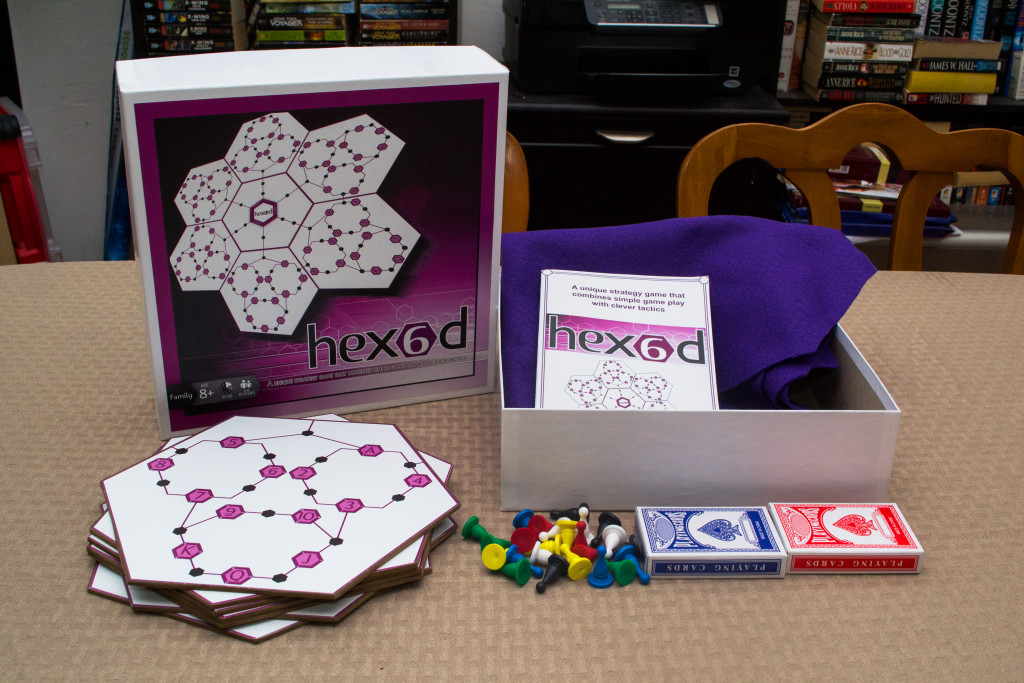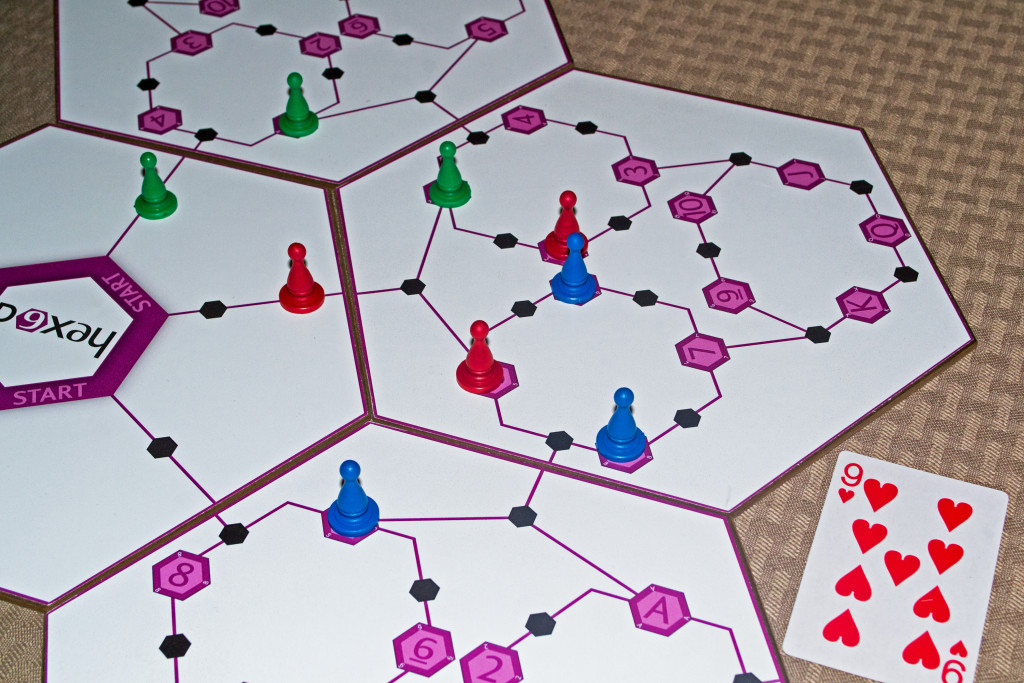If there’s one game that we can all agree to play on family game night, it’s “Sequence”. I mean, it’s just so easy to play: play a card, place a chip, draw a card. “Hex6d” (a game that will be launching on Kickstarter in March of 2015) reminds me a bit of “Sequence” in the sense that you’re using playing cards to manipulate the pieces on the board, though there are some distinct differences. Before we get into what those differences are, I’d like to quickly thank game creator Dana Muchow for reaching out and providing me with a prototype copy for preview purposes. It’s important to stress that prototypes aren’t usually reflective of the final product, making the rules and components featured below subject to change.
My prototype copy came with a total of 7 Hex Tiles (1 Starting Hex & 6 Playing Field Hexes), 2 Standard Playing Card Decks, and 24 Pawns (6 Colors, 4 Pawns Each). The game can be set up a number of different ways, what with the board being modular. In the standard game, the Starting Hex is placed onto the center of the table with a number of Playing Field Hexes connecting to it equal to the number of players in the game. If three players are playing, for example, then you’d connect three Playing Field Hexes to the Starting Hex. Both decks of cards are shuffled together and cut into two draw decks (so that players on either side of the table can easily reach them). Players choose a color and place three of their pawns onto the Starting Hex, receive three cards from any deck, and pick a starting player at random.
Before we begin, it’s worth emphasizing the difference between the terms “hex” and “spot”. Each hex has a number of different spots (or spaces). Each spot lists a different numbered or lettered value found in a regular deck of cards.
On a player’s turn, they’ll draw a card from the closest draw pile. If no cards are available, they’ll simply reshuffle the discard pile and make it a new draw deck. Once a player draws a card, they’ll play one card from their hand and move one or more of their pawns the appropriate number of spots. Playing an Ace (1) through 10 will allow the player to move one pawn the value shown on the card. Playing a Jack allows the player to move an opponent’s pawn five spaces, whereas a Queen allows them to move one or more of their own pawns a total of five spaces. A King allows the player to move one of their pawns anywhere from one to five spaces. Finally, a Joker simply has players passing their hand to their right (no pawns are moved).
There are, of course, some movement rules to observe. Pawns can’t jump other pawns (even your own) and cannot be moved “back and forth” during a single turn (though you can create a “circle” if a high enough card is played). Two pawns cannot occupy the same spot and once the pawns leave the Starting Hex, it’ll act as a regular Playing Field Hex. If a player cannot move their pawn the required number of spaces after drawing a card, they’ll simply discard a card and end their turn. It’s possible for this to happen, especially if you opt to utilize a Hex setup to where the Playing Field Hexes don’t touch (“Y-shaped” board, for example), thereby limiting access to the other hexes. Players can also opt to start with more or less pawns to change the difficulty, if they so desire. In summary, the less hexes touch and the more pawns you add, the more congested things will get.
The objective of the game is to be the first player (at the end of your turn) to align your pawns onto the Playing Field Hexes in such a way that the spots they are on matches every card in your hand. If a player has a 2, 3, and 4 in their hand for example, they’ll win if they manage to get their pawns on the 2, 3, and 4 spots. This is why players start the game with three pawns and a hand size of three cards (one pawn for each card). The one card they draw can be used for movement or saved to lock in a more convenient objective spot. As I mentioned above, players can add more hexes or pawns if they want, just be sure to increase your hand size appropriately so that there is one card in your hand for each of your pawns in play.
“Hex6d” is the kind of game you can safely bring to your grandmother’s house without having to worry about her complaining that “those complicated board games are the work of the devil.” Along those lines, it has some really great ideas and I love how easy it is to pick up and play. The prototype manual is only about two pages long, give or take, so learning the game will take no time at all. The modular playing area will help to ensure that each game is relatively different, even if the objective is still the same. All in all, “Hex6d” is an easy recommend for folks who enjoy playing games that combine card play with somewhat typical board game components (like “Sequence”).
—
You can learn more about and support “Hex6d” by visiting its Kickstarter page, here:
https://www.kickstarter.com/projects/2037406892/hex6d-a-strategy-board-game
—


